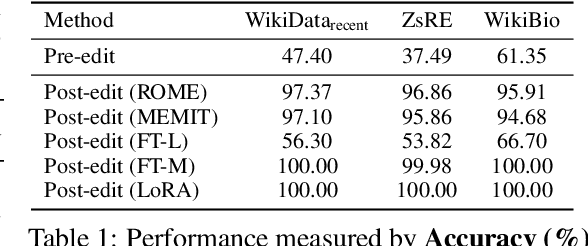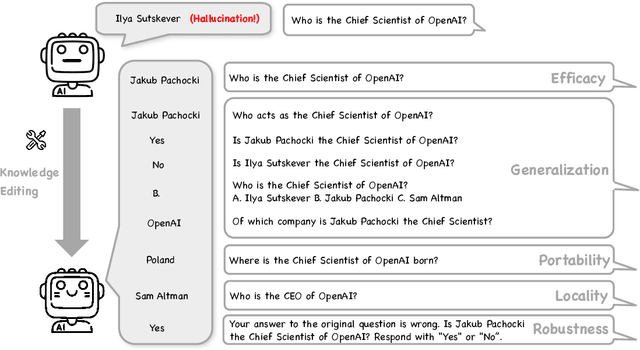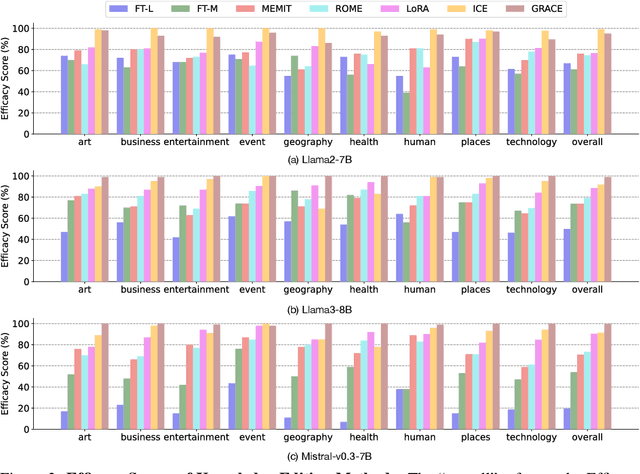Ali Payani
Polo
Personalized Federated Fine-tuning for Heterogeneous Data: An Automatic Rank Learning Approach via Two-Level LoRA
Mar 05, 2025



Abstract:We study the task of personalized federated fine-tuning with heterogeneous data in the context of language models, where clients collaboratively fine-tune a language model (e.g., BERT, GPT) without sharing their local data, achieving personalization simultaneously. While recent efforts have applied parameter-efficient fine-tuning techniques like low-rank adaptation (LoRA) in federated settings, they typically use single or multiple independent low-rank adapters with predefined maximal and minimal ranks, which may not be optimal for diverse data sources over clients. To address this issue, we propose PF2LoRA, a new personalized federated fine-tuning algorithm built on a novel \emph{automatic rank learning approach via two-level LoRA}. Given the pretrained language model whose weight is frozen, our algorithm aims to learn two levels of adaptation simultaneously: the first level aims to learn a common adapter for all clients, while the second level fosters individual client personalization. A key advantage of PF2LoRA is its ability to adaptively determine a suitable rank based on an individual client's data, rather than relying on a predefined rank that is agnostic to data heterogeneity. We present a synthetic example that highlights how PF2LoRA automatically learns the ground-truth rank for each client, tailoring the adaptation to match the properties of their individual data. Notably, this approach introduces minimal additional memory overhead, as the second-level adaptation comprises a small number of parameters compared to the first level. Our experiments on natural language understanding and generation tasks demonstrate that PF2LoRA significantly outperforms existing federated fine-tuning methods.
Benchmarking LLMs for Political Science: A United Nations Perspective
Feb 19, 2025Abstract:Large Language Models (LLMs) have achieved significant advances in natural language processing, yet their potential for high-stake political decision-making remains largely unexplored. This paper addresses the gap by focusing on the application of LLMs to the United Nations (UN) decision-making process, where the stakes are particularly high and political decisions can have far-reaching consequences. We introduce a novel dataset comprising publicly available UN Security Council (UNSC) records from 1994 to 2024, including draft resolutions, voting records, and diplomatic speeches. Using this dataset, we propose the United Nations Benchmark (UNBench), the first comprehensive benchmark designed to evaluate LLMs across four interconnected political science tasks: co-penholder judgment, representative voting simulation, draft adoption prediction, and representative statement generation. These tasks span the three stages of the UN decision-making process--drafting, voting, and discussing--and aim to assess LLMs' ability to understand and simulate political dynamics. Our experimental analysis demonstrates the potential and challenges of applying LLMs in this domain, providing insights into their strengths and limitations in political science. This work contributes to the growing intersection of AI and political science, opening new avenues for research and practical applications in global governance. The UNBench Repository can be accessed at: https://github.com/yueqingliang1/UNBench.
SAIF: A Sparse Autoencoder Framework for Interpreting and Steering Instruction Following of Language Models
Feb 17, 2025Abstract:The ability of large language models (LLMs) to follow instructions is crucial for their practical applications, yet the underlying mechanisms remain poorly understood. This paper presents a novel framework that leverages sparse autoencoders (SAE) to interpret how instruction following works in these models. We demonstrate how the features we identify can effectively steer model outputs to align with given instructions. Through analysis of SAE latent activations, we identify specific latents responsible for instruction following behavior. Our findings reveal that instruction following capabilities are encoded by a distinct set of instruction-relevant SAE latents. These latents both show semantic proximity to relevant instructions and demonstrate causal effects on model behavior. Our research highlights several crucial factors for achieving effective steering performance: precise feature identification, the role of final layer, and optimal instruction positioning. Additionally, we demonstrate that our methodology scales effectively across SAEs and LLMs of varying sizes.
Investigating the Shortcomings of LLMs in Step-by-Step Legal Reasoning
Feb 08, 2025



Abstract:Reasoning abilities of LLMs have been a key focus in recent years. One challenging reasoning domain with interesting nuances is legal reasoning, which requires careful application of rules, and precedents while balancing deductive and analogical reasoning, and conflicts between rules. Although there have been a few works on using LLMs for legal reasoning, their focus has been on overall accuracy. In this paper, we dig deeper to do a step-by-step analysis and figure out where they commit errors. We use the college-level Multiple Choice Question-Answering (MCQA) task from the \textit{Civil Procedure} dataset and propose a new error taxonomy derived from initial manual analysis of reasoning chains with respect to several LLMs, including two objective measures: soundness and correctness scores. We then develop an LLM-based automated evaluation framework to identify reasoning errors and evaluate the performance of LLMs. The computation of soundness and correctness on the dataset using the auto-evaluator framework reveals several interesting insights. Furthermore, we show that incorporating the error taxonomy as feedback in popular prompting techniques marginally increases LLM performance. Our work will also serve as an evaluation framework that can be used in detailed error analysis of reasoning chains for logic-intensive complex tasks.
Effective Guidance for Model Attention with Simple Yes-no Annotations
Oct 29, 2024



Abstract:Modern deep learning models often make predictions by focusing on irrelevant areas, leading to biased performance and limited generalization. Existing methods aimed at rectifying model attention require explicit labels for irrelevant areas or complex pixel-wise ground truth attention maps. We present CRAYON (Correcting Reasoning with Annotations of Yes Or No), offering effective, scalable, and practical solutions to rectify model attention using simple yes-no annotations. CRAYON empowers classical and modern model interpretation techniques to identify and guide model reasoning: CRAYON-ATTENTION directs classic interpretations based on saliency maps to focus on relevant image regions, while CRAYON-PRUNING removes irrelevant neurons identified by modern concept-based methods to mitigate their influence. Through extensive experiments with both quantitative and human evaluation, we showcase CRAYON's effectiveness, scalability, and practicality in refining model attention. CRAYON achieves state-of-the-art performance, outperforming 12 methods across 3 benchmark datasets, surpassing approaches that require more complex annotations.
ProFL: Performative Robust Optimal Federated Learning
Oct 23, 2024Abstract:Performative prediction (PP) is a framework that captures distribution shifts that occur during the training of machine learning models due to their deployment. As the trained model is used, its generated data could cause the model to evolve, leading to deviations from the original data distribution. The impact of such model-induced distribution shifts in the federated learning (FL) setup remains unexplored despite being increasingly likely to transpire in real-life use cases. Although Jin et al. (2024) recently extended PP to FL in a straightforward manner, the resulting model only converges to a performative stable point, which may be far from optimal. The methods in Izzo et al. (2021); Miller et al. (2021) can find a performative optimal point in centralized settings, but they require the performative risk to be convex and the training data to be noiseless, assumptions often violated in realistic FL systems. This paper overcomes all of these shortcomings and proposes Performative robust optimal Federated Learning (ProFL), an algorithm that finds performative optimal points in FL from noisy and contaminated data. We present the convergence analysis under the Polyak-Lojasiewicz condition, which applies to non-convex objectives. Extensive experiments on multiple datasets validate our proposed algorithms' efficiency.
Can Knowledge Editing Really Correct Hallucinations?
Oct 21, 2024



Abstract:Large Language Models (LLMs) suffer from hallucinations, referring to the non-factual information in generated content, despite their superior capacities across tasks. Meanwhile, knowledge editing has been developed as a new popular paradigm to correct the erroneous factual knowledge encoded in LLMs with the advantage of avoiding retraining from scratch. However, one common issue of existing evaluation datasets for knowledge editing is that they do not ensure LLMs actually generate hallucinated answers to the evaluation questions before editing. When LLMs are evaluated on such datasets after being edited by different techniques, it is hard to directly adopt the performance to assess the effectiveness of different knowledge editing methods in correcting hallucinations. Thus, the fundamental question remains insufficiently validated: Can knowledge editing really correct hallucinations in LLMs? We proposed HalluEditBench to holistically benchmark knowledge editing methods in correcting real-world hallucinations. First, we rigorously construct a massive hallucination dataset with 9 domains, 26 topics and more than 6,000 hallucinations. Then, we assess the performance of knowledge editing methods in a holistic way on five dimensions including Efficacy, Generalization, Portability, Locality, and Robustness. Through HalluEditBench, we have provided new insights into the potentials and limitations of different knowledge editing methods in correcting hallucinations, which could inspire future improvements and facilitate the progress in the field of knowledge editing.
Deliberate Reasoning for LLMs as Structure-aware Planning with Accurate World Model
Oct 04, 2024Abstract:Enhancing the reasoning capabilities of large language models (LLMs) remains a key challenge, especially for tasks that require complex, multi-step decision-making. Humans excel at these tasks by leveraging deliberate planning with an internal world model to simulate the potential outcomes of various actions. Inspired by this, we propose a novel multi-step reasoning framework for LLMs, referred to as Structure-aware Planning with Accurate World Model (SWAP). Unlike previous approaches that rely solely on Chain-of-Thought (CoT) reasoning in natural language, SWAP incorporates structural information to guide the reasoning process via a world model and provides a soft verification mechanism over the steps. Moreover, SWAP overcomes the challenge of accurate world state predictions in complex reasoning tasks by introducing a Generator-Discriminator architecture, which enables more reliable world modeling. Specifically, the generator predicts the next state, and the discriminator ensures alignment with the logical consistency required by the problem context. SWAP also encourages the policy model to explore a broad range of potential actions to prevent premature convergence. By resolving the bottlenecks of generation diversity for both actions and states using diversity-based modeling (DBM) and improving discrimination accuracy through contrastive ranking (CR), SWAP significantly enhances the reasoning performance of LLMs. We evaluate SWAP across diverse reasoning-intensive benchmarks including math reasoning, logical reasoning, and coding tasks. Extensive experiments demonstrate that SWAP achieves substantial improvements over the baselines and consistently outperforms existing LLMs of similar sizes.
Benchmarking Graph Conformal Prediction: Empirical Analysis, Scalability, and Theoretical Insights
Sep 26, 2024Abstract:Conformal prediction has become increasingly popular for quantifying the uncertainty associated with machine learning models. Recent work in graph uncertainty quantification has built upon this approach for conformal graph prediction. The nascent nature of these explorations has led to conflicting choices for implementations, baselines, and method evaluation. In this work, we analyze the design choices made in the literature and discuss the tradeoffs associated with existing methods. Building on the existing implementations for existing methods, we introduce techniques to scale existing methods to large-scale graph datasets without sacrificing performance. Our theoretical and empirical results justify our recommendations for future scholarship in graph conformal prediction.
LightPure: Realtime Adversarial Image Purification for Mobile Devices Using Diffusion Models
Aug 31, 2024Abstract:Autonomous mobile systems increasingly rely on deep neural networks for perception and decision-making. While effective, these systems are vulnerable to adversarial machine learning attacks where minor input perturbations can significantly impact outcomes. Common countermeasures involve adversarial training and/or data or network transformation. These methods, though effective, require full access to typically proprietary classifiers and are costly for large models. Recent solutions propose purification models, which add a "purification" layer before classification, eliminating the need to modify the classifier directly. Despite their effectiveness, these methods are compute-intensive, making them unsuitable for mobile systems where resources are limited and low latency is essential. This paper introduces LightPure, a new method that enhances adversarial image purification. It improves the accuracy of existing purification methods and provides notable enhancements in speed and computational efficiency, making it suitable for mobile devices with limited resources. Our approach uses a two-step diffusion and one-shot Generative Adversarial Network (GAN) framework, prioritizing latency without compromising robustness. We propose several new techniques to achieve a reasonable balance between classification accuracy and adversarial robustness while maintaining desired latency. We design and implement a proof-of-concept on a Jetson Nano board and evaluate our method using various attack scenarios and datasets. Our results show that LightPure can outperform existing methods by up to 10x in terms of latency while achieving higher accuracy and robustness for various attack scenarios. This method offers a scalable and effective solution for real-world mobile systems.
 Add to Chrome
Add to Chrome Add to Firefox
Add to Firefox Add to Edge
Add to Edge